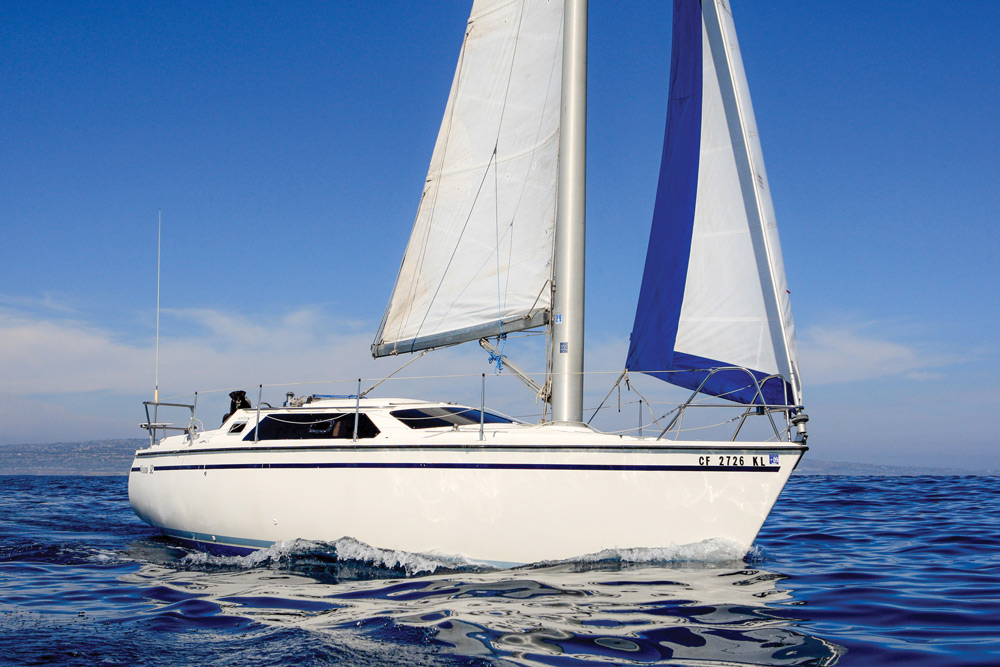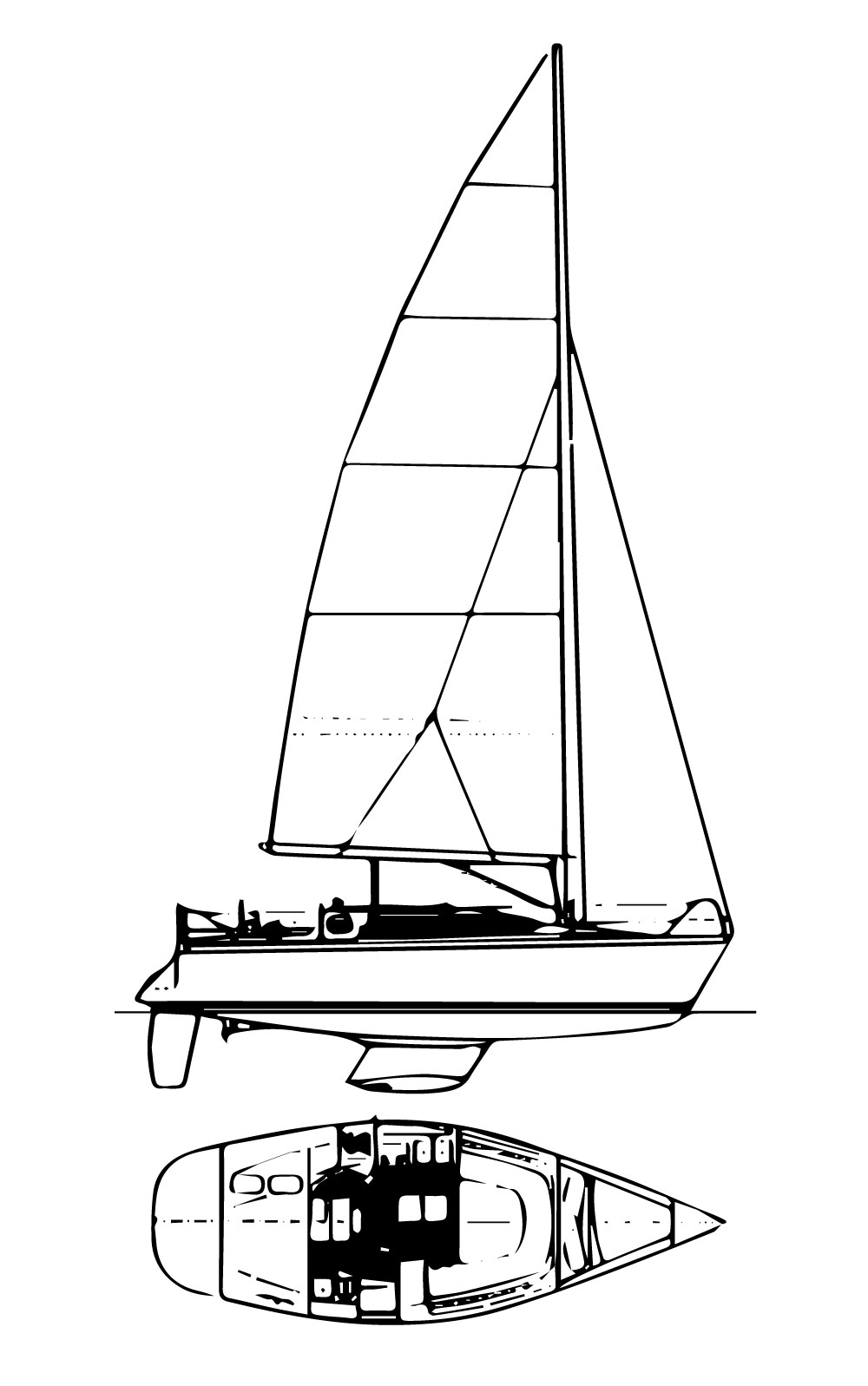Hunter Vision 32
This recreational coastal cruiser is designed for effortless sailing
The Hunter Vision 32 has been described as a lazy sailor’s boat because it’s so effortless to sail.
Key characteristics aboard this sloop mirror those found on earlier Freedom Yachts boats designed by Garry Hoyt. There are no shrouds, spreaders or backstay.
The keelboat’s free-standing aluminum mast is located forward in the boat, giving the boat a quasi-catboat appearance. The rig accommodates a simple sailplan that presents few complications.
Created by the Hunter Marine design team, the boat attracted loads of attention when launched in the late 1980s. In reviewing online discussions of the Vision 32 posted over the past three decades, it’s obvious sailors loved them or hated them with few opinions in between.
“Looks like a streetlamp pole holding an enormous mainsail in its quasi-cat-rigged set up,” wrote Patrick Reynolds in an American Sailing Association publication.

The Hunter Marine marketing team in 1988 pitched the Vision 32 as a coastal cruiser and weekender, near perfect for overnight trips and with enough space below deck for family and friends. The team also heralded simplicity of sailing and ease of handling, making note of its roomy interior and useable space even while the boat is under way.
First impressions
The Hunter Vision 32 is difficult to ignore with its novel rig. The sloop’s beefy mast is set forward farther than what might be considered traditional.
Naval architect Robert Perry once noted in a SAILING Magazine design review that the Vision 32 was aimed at the person buying their first cruising boat.
“Perhaps this sailor has been intimidated by standard rigs with their implied complexity. Hunter has put this innovative design together with comfort and simplicity receiving equal attention,” Perry wrote.
According to Perry, the fractional-rig sloop, while short-ended with high freeboard and a large cabinhouse, is nonetheless good-looking. As he put it, “It shows careful attention to styling. The house contours are very pleasing and add a very rakish look to this somewhat chunkily-proportioned hull.”
Construction
The keelboat’s hull is primarily made of solid, hand-laid fiberglass. The hull is internally reinforced by a one-piece, box-beamed grid system bonded by glass to the hull. It has an internally-mounted, spade-type rudder and a fixed fin keel. The large bulb lowers the center of gravity and increases stability.
The wraparound portlights are similar in design to those found on Beneteau, Jeanneau and other popular boats in Europe.
What to look for
Sailors considering the purchase of a Vision 32 should inspect the fuel, holding and freshwater tanks for leaks and corrosion. All three tanks are made of aluminum.

Another aluminum tank is located under the swim step and may show signs of corrosion. Checking for leakage around the mast at the deck level and for rot under the water heater base was advised.
In a review of the Vision 32, owner Mike Webster expressed dissatisfaction with the sail controls.
“The mainsheet system was real weak and could only be used in light air. The mainsail was hard to raise, but on the other hand, it’s the main of a 40-foot boat,” he wrote.
Difficulty raising the mainsheet has been a steady topic of discussion since the boat was launched and various means to alleviate the problem have been proposed.
On deck
The unstayed mast is keel-stepped farther forward in the boat than what might be expected aboard a traditional sloop. The 53-foot mast is a height that allows clearance beneath fixed highway bridges in most ports in the United States.
The sloop’s sturdy rig handles a large mainsail that some owners note is the size typically found aboard 40-foot boats. Lazy jacks help guide the mainsail to its resting place on the boom. A roller furler tames the jib. The boat has two Barient 21 primary winches and a Schaefer traveler system.
Online forums voice complaints about the difficulty of raising the large, full-batten mainsail. Installing an electric winch and switching to a smaller diameter halyard are usually mentioned as solutions. The Vision 32 mainsail winches were manually operated.
The boat’s wide beam not only increases overall stability but provides the crew with more work space when moving fore and aft along the sidedecks. The absence of shrouds also makes this passage easier.
A stainless steel recessed grabrail runs the length of the cabintop. All control lines lead back to the cockpit with its Edson steering wheel and comfortable seating arrangement.
From behind the helm, a gate makes for convenient access to the swim platform, which is inserted into the reverse transom. A stainless steel boarding ladder and a shower hose and nozzle complete the user-friendly setup.
Down below
The Vision 32 has lots to like below deck in addition to its roominess and plentiful natural light.
The boat has a private cabin aft for two and tighter sleeping quarters for two more crew in the V-berth. The dinette is convertible and can create another two berths for a total of six.
The saloon has 6 feet 3 inches of headroom, so the majority of sailors won’t have to stoop. The galley has a double-basin stainless sink, stove, and a refrigerator built into the center island. There’s one head with a compact shower, the materials primarily made of plastic for easy maintenance and cleaning. The boat even has a nav station where electronics can be located and charts examined. A hanging locker provides storage of equipment or foul-weather gear.
There’s no shortage of natural light since the boat has five opening port lights and three opening hatches. A teak-and-holly sole lends warmth to the interior.
The boat carries 45 gallons of fresh water. The original waste tank was built to hold 12 gallons but some owners have installed a larger tank.
Webster praised the boat’s livability.
“It’s very livable for short periods of time. I have had as many as six people on board for three-day weekends. Crowded? Yes, but try that on most 32-footers.”
Engine
The boat is outfitted with a Japanese Yanmar 3GM30f diesel engine that puts out 27 horsepower. The engine is accessible from three sides for maintenance and inspection. The fuel tank carries 22 gallons of diesel.
Underway
One Florida yacht broker praised the boat’s reputation for being affordable and easy to singlehand. “It’s a reasonable performer for coastal cruising,” he said. “And provides lots of accommodation for
the money.”
Another called the Vision 32 “a great little island hopper” designed for sailing short distances in coastal waters.
In his post on a Hunter owners’ forum, Webster noted the boat “has a great wide open cabin with lots of natural light, and is easy to sail and singlehand in a real blow with non-sailing friends aboard.”
A shortage of handholds both on deck and below was cited by different owners.
One owner actually increased the number of handholds by 10.
“The interior works well at anchor or at the dock, but not in a heavy sea,” he said.
Although some owners contend the mast thickness can create a turbulent zone that makes the mainsail work harder and less efficiently, most are satisfied with the arrangement. The sail can be flown nearly perpendicular since there are no shrouds to impede the angle.
Conclusion
The Hunter Vision 32 is a safe and comfortable coastal cruising boat that allows for near effortless sailing.
LOA 32’; LWL 28’ 9”; Beam 11’4; Draft (bulb) 4’3”; Displacement 11,400 lb.; Ballast 4,500 lb.; Sail Area 567 sq. ft.
General Market Price Data: 1991 Wisconsin $55,000; 1990 California $44,500; 1989 Louisiana $29,000
SAILING’s Value Guide
(5-sailboat rating system)
Price: Prices for a Hunter Vision 32 in summer 2024 ranged from a high of $55,000 for a 1991 boat in Wisconsin to a low of $29,000 in Louisiana for a boat built in 1989. 3 sailboats
Design Quality: The sloop was designed by the Hunter Marine team and reflects influences from earlier Freedom Yachts boats designed by Garry Hoyt due to the absence of shrouds, spreaders and backstay. 3 sailboats
Construction Quality: The recreational sloop was solidly constructed by Hunter Marine at its Florida headquarters and is considered a midrange quality production boat ideal for coastal cruising. 3 sailboats
User-Friendliness: The Hunter Vision 32 is known for its friendly sailing characteristics, is easy to singlehand, capable on most points of sail, and generally comfortable above and below deck. Hunter Marine marketed the boat as one that allows effortless sailing. 3 sailboats
Safety: The boat has the usual lifelines and stainless rails, a transom gate and swim platform for easy boarding, a wide beam for stability and a bulb keel that lowers the center of gravity, providing additional stability. A stainless steel grabrail runs the length of the cabintop. 3 sailboats
Typical Condition: Brokers note the Vision 32 has held up over the past three decades and those for sale are often in good condition. 3 sailboats
Refitting: Owners have added 30-pound stainless plow anchors with 35 feet of chain to supplement the provided Danforth anchor and chain. Most owners by now have replaced sails because the boats are more than 30 years old. Some owners have installed an electric head and replaced the aluminum fuel, water, and holding tanks. Replacement of aging portlights is also noted by owners. Additional upgrades include an autopilot, fiddle rails, anchor wash down pump, electric mainsail winch, and a Harken traveler to replace the Schaefer equipment. 3 sailboats
Support: Marlow-Hunter Co. is located in Alachua, Florida, and can be contacted by phone at (386) 462-3077. Owners requesting assistance are usually referred to Hunter dealers around the country for parts or service. Groups of Hunter owners offer advice and recommendations online. Among them are www.hunter.sailboatowners.com, and www.hsa1.org. A Hunter owners’ Facebook group at www.facebook.com/groups/hunterowners also offers support as does www.cruiserforum.com. 2.5 sailboats
Availability: The Vision 32 was introduced in 1988 and produced for six years before it was discontinued. At least nine Hunter Vision 32s were for sale in the continental United States in summer 2024, in Arkansas, Arizona, California, Florida, New York, Rhode Island, Tennessee and Wisconsin. 3.5 sailboats
Investment and Resale: According to a J.D. Power product rating, a 1990 Hunter Vision 32 with an original base price of $63,826 currently has a low retail price $28,350 and an average retail price of $32,100. Current asking prices are higher than those listed in the J.D. Power rating. One owner commented that his father owned a Vision 32 for 11 years and then sold it for what he paid for it despite the mixed review of this somewhat unique boat. 3.5 sailboats
Overall ‘SVG’ Rating: 3 sailboats

Comments